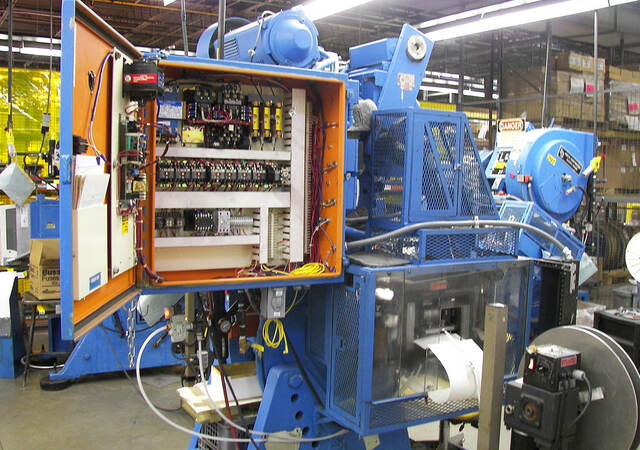To help you learn more about how the requirements for protection from electrical hazards have been revised according to the 2021 edition of the NFPA 79, UL Solutions and Eaton Bussmann division experts have teamed up to provide answers to the following frequently asked questions from our related webinar.
Many disconnect switches have some type of defeat mechanism that will allow the operator to open the enclosure without turning the power off. What level of protection should be in the enclosure for this type of disconnect switch?
If it is a "defeat mechanism," the assumption is that it is interlocked with the door. In this case, the example would fall under 6.2.3.1 (2) and 6.2.3.2 enclosure interlocking. The phrase “Access shall be permitted without removing power” in 6.2.3.2 would apply to the use of a “defeat mechanism.” The live parts mounted on the door must be protected from unintentional direct contact (2" sphere). All other live parts in the panel do not have to be guarded or finger safe.
A condition of enclosure access allows use of a key or tool. Is a slotted bit insert thus requiring a slotted screwdriver an acceptable tool as a slotted bit can be easily opened with items other than a screwdriver, such as a coin.
Yes, there is no definition of tool, so a coin could be considered a tool as you see one often used on panelboards.
Considering that the incident energy computed by the Institute of Electrical and Electronics Engineers (IEEE) 1584 changes with the enclosure, how does the National Fire Protection Association manage to define a recommended distance to the enclosures where an arc flash could occur, or does it recommend to perform the computation of the IEEE 1584?
In regard to arc flash, NFPA 79 only requires an arc flash hazard warning label be provided (6.6 arc flash hazard warning and 16.2.3 safety sign requirements). This is the same label requirement in the National Electrical Code® (NEC) 110.16 (A).
How would 6.2.3.1 apply to a control transformer or an open core power transformer?
If the transformer is finger safe or guarded, it’s possible it would fall under condition 1 (if provided on the inside of a door or cover) or 3. If not, the transformer would fall under condition 2 of 6.2.3.1.
Does plexiglass fall under insulation?
Plexiglass is considered a barrier and would not be considered insulation of live parts. Plexiglass would fall under enclosure access (6.2.3.1 (3)) for guarded live parts.
Where did the 50 volt (V) root mean square (rms) value originate?
The 30V rms, 42.4Vpeak (pk) and 60V direct current (DC) values represent the maximums for Class 2 and low voltage limited energy circuits and a limited power source. In industrial applications, it has been determined that a higher value of voltage is allowed. The NFPA 79 committee has determined that 50V represents a maximum hazardous touch voltage. It is assumed that equipment in an industrial environment is only exposed to trained and/or authorized personnel. Hence, the allowance for a higher voltage than what is allowed for class 2 and similar circuits. The NFPA 70E standard for workplace safety also considers 50V or greater as a hazardous touch voltage. It is important to note that 70E applies the 50V maximum to both alternating current (AC) and DC. A task group is looking at these differences to determine if the two standards relative to hazardous voltages should be consistent.
If a manufacturer has a multi-section enclosure that has a disconnect in one of the sections where that disconnect provides power to the other sections, is it correct that they do not need to interlock, either mechanically or electrically, the door of the section that contains the disconnect with the doors of the other sections that are supplied by that disconnect?
It is correct that the doors of the sections that are supplied by the disconnect do not need to be interlocked with the door of the section that contains the disconnect. However, there are requirements applying to the doors of those other sections that must be satisfied. You have two choices. First, the use of a key or tool must be necessary to access those sections and all live parts mounted on the inside of doors of those sections need to be protected from unintentional direct contact with live parts that represent a shock hazard. For the second choice, the use of a key or tool is not necessary to access those sections provided that all live parts in those sections that represent a shock hazard are protected from unintentional contact.
If a machine has one main industrial control panel which powers the machine, and all of its components are finger safe, do you have to interlock the main disconnect with the door?
No interlocking is needed. This would fall under the third condition, NFPA 79 6.2.3.1 (3), which states, “Opening without the use of a key or a tool and without disconnection of live parts shall be permitted only when all live parts inside that are operating at or above 50 volts rms AC or 60 volts DC are separately enclosed or guarded such that there cannot be any contact with live parts. A safety sign shall be provided in accordance with 16.2.4.”
Get in touch
Have questions, need specifics? Let's get this conversation started.




